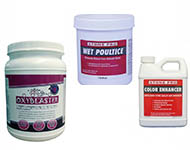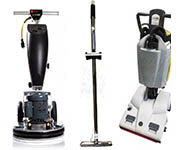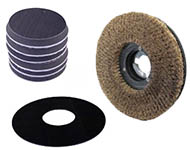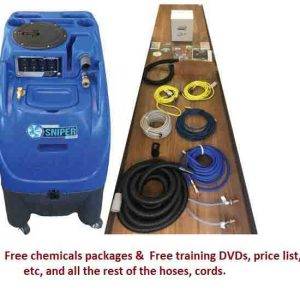-
-
Tap into tiles and grout
Tips for inspecting and cleaning tile, grout.
By Taf Baig
From June 2002 edition of Cleanfax magazine. For a free introductory subscription, click here.
As tile and grout cleaning moves from low tech to high tech, more carpet cleaning companies are finding gold in this new business. This untapped market produces returns from 50 cents to $1.50 per square foot and all you need are a few tools and chemicals that work with your existing truckmount and portable. However, many carpet cleaners are reluctant to get into this business, mainly because they are not sure how to perform the service.
They’re afraid that they will ruin something, and while these fears are understandably true, a little education can quickly overcome any fears you may have.
Tile tales
Rich Absher, a tile and grout cleaning instructor for Hydro-Force, Salt Lake City, UT, lists four different groups of tiles:
- Man-made hard ceramic and porcelain
- Natural stone
- Vinyl
- Soft clay
There are also 4 major types of grout:
- Sanded lime-based cementitious
- Unsanded lime-based cementitious
- Sanded epoxy-based
- Unsanded epoxy-based
If you’re a beginner, you should first learn to clean the most common tiles and grout until you gain more experience. How do you know what is common and what is not? Four tests may need to be done to determine the suitability of the floor to be cleaned, according to Absher. The goal is to check to see if it?s man-made or natural.
-
Learn to identify the tile type before attempting to clean.
1. Does the tile pattern repeat?
In a large room, you would see the man-made tile repeated in a combination of four to six different tiles. With natural stone, every tile would be different and has the 1/16th bevelled edge. Tile manufacturers are making more and more look-a-likes that try to duplicate real stone in every way, which makes this task even more difficult.
Don’t be alarmed. Just visit your local flooring store to learn to tell the difference visually. A trained eye can usually determine whether it?s man-made or natural by sight alone. Scott Rendall, of BRC Systems and owner of Sci-Clean in Brighton, MI, says
good inspection is most important and suggests looking for chips or broken tiles. Make sure grout is intact, he said. When cleaning marble or other natural tiles, don’t use acid because it will etch the surface.?If the tile pattern repeats, then it?s man-made. The following three tests are necessary only if you haven?t determined this from the previous test.
2. Determine surface porosity
Placing a few drops of water on the tile. Some tiles will show an immediate absorption of water. There’s a range of porosity and even the densest stone-like granite will allow water to flow through it, even though it could take more than 10 minutes to fully penetrate the surface and more than 30 minutes to work through the whole tile.
Most ceramic tile is relatively non-porous. The more porous the tile, the more prone the tile is to efflorescence as a result of cleaning. You may notice some efflorescence, a precipitate that has the appearance of a white, chalky, powder-like substance on the surface of the grout and most porous tiles, especially darker tiles.
-
A free demonstration is a great way to sell customers on tile cleaning.
To remove it, allow adequate drying time for the minerals to accumulate completely to the surface of the grout or tile, then buff it out using an abrasive pad or brush.
3. Scratch the tile
Scratch the surface of the tile with a sharp knife. Make sure you ask for permission since you wouldn’t want to replace the tile
at your expense. Find an inconspicuous area where you are going to test or get a piece of extra tile. If the stone scratches, high pressure may not be the ideal cleaning method. If caution is taken to make sure no dirt gets trapped under the tools being
used, then these tools can be used at lower pressures. The softer the tile, the lower the pressure.4. Apply phosphoric acid
If it fizzes, then the tile is natural. In the beginning, you will avoid natural stones, but if you test first, then you can successfully clean even the softest of stone tiles.
Grout and about
The problem with grout is that each time tile is mopped, dirt gets pushed down into the grout lines, making it several times
dirtier than the tile.
-
Efflorescence is a white, chalky substance that can be buffed off using an abrasive pad or brush.
- We have found two things to work well on grout,? Sam Samad, regional sales manager for Magic Wand Company, said. ?One is a concentration of high pressure and the other is a tile safe bleach product.?The pressure is necessary to get into the small opening of grout to blow out the dirt.
- The bleach is necessary to bleach away years of dirt that have been absorbed into the grout.
- The key is the dwell-time with this product; the dirtier the grout, the longer the dwell time.
- It is important to keep the area wet while the chemical is allowed to work.
Two grout types
Cementitious grout and epoxy grout are basically the two types of grout, Absher says. The way to tell the difference between them is to take a knife and try to cut it in an inconspicuous area. Cementitious grout will be dry and powdery because it is lime based, while epoxy grout can be cut into like plastic. Epoxy grout also does not need to be sealed, since it will not absorb moisture like an unsealed cementatious grout. Do not deliberately try to seal an epoxy grout or your efforts will be in vain.
- High-pressure tile cleaning can have dramatic results.
- Most grout will come clean, but if it still looks blotchy Samad recommends using one to 10 parts of muriatic acid. Apply it with a towel on the grout only, and rinse it out within two minutes.
- You can increase the concentration if the grout does not respond.
- Only use this on cementitious grout as a last resort.
-
This is an industry that belonged to the janitorial and maid service industry but has seamlessly connected itself to ours as we’ve developed tools and chemicals that work in conjunction with our truckmounts and portables to
produce jaw-dropping results.Taf Baig is president of Magic Wand Company, a manufacturer and distributor of carpet cleaning tools, equipment and supplies. He is also president of a very successful carpet and furniture cleaning company. He owns patents for several tools and pieces of equipment. To e-mail him, visit www.magicwandco.com.
-






